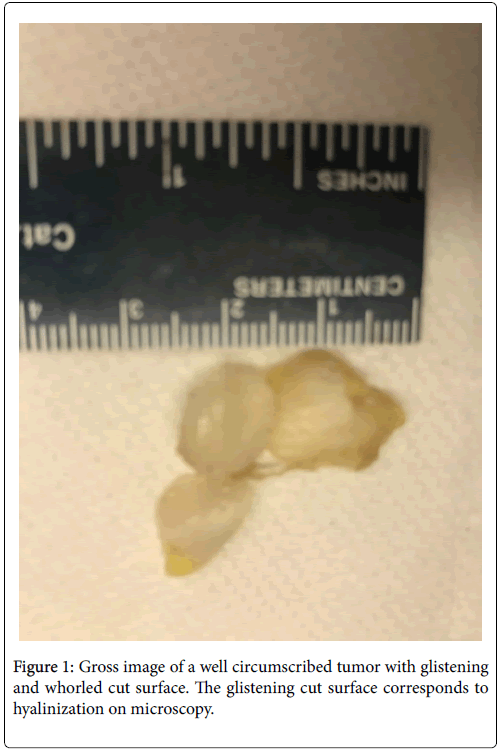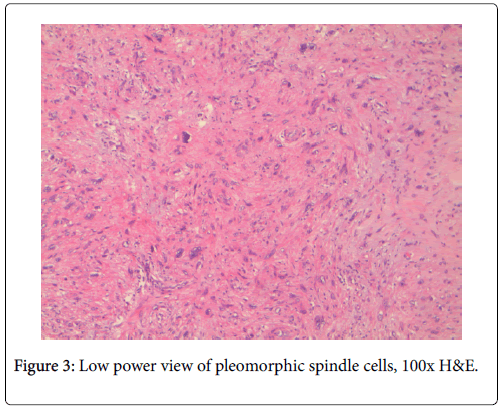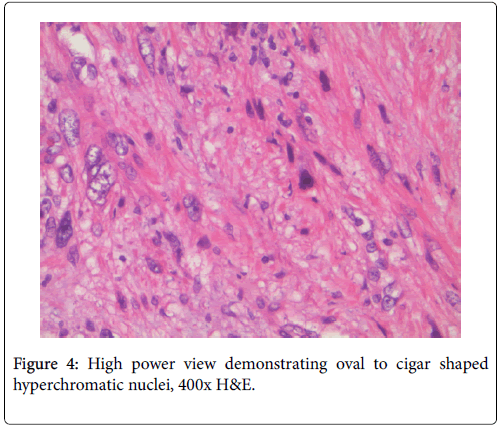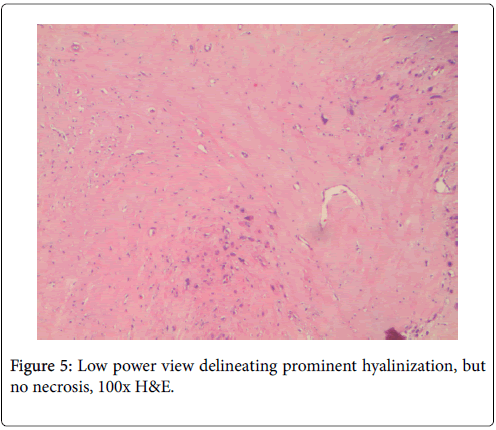A Superficial Leiomyosarcoma of the Ankle: Case Report
Received: 03-Aug-2018 / Accepted Date: 20-Oct-2018 / Published Date: 23-Oct-2018 DOI: 10.4172/2476-2024.1000145
Abstract
Leiomyosarcoma of the ankle is a rare occurrence. It typically manifests in the 4th to 6th decades of life with no definite gender predilection. Frequently, it is misdiagnosed clinically as a benign entity due to a seemingly indolent disease course. Herein, we describe an 81-year old gentleman who presented to his primary care physician with a complaint of painful right ankle lump.
Keywords: Superficial leiomyosarcoma; Ankle
Introduction
Leiomyosarcomas are malignant mesenchymal tumors which constitute approximately 1% of all malignancies. Mesenchymal tumors fall under the broad category of sarcomas, with more than fifty subtypes. Leiomyosarcoma, in particular, is a sarcoma involving involuntary smooth muscle. They are usually ascribed to uterus and abdominal cavity. Among extra-peritoneal sites there is a proclivity for the lower extremities though the ankle is not a common presentation for leiomyosarcoma. A review of PubMed English literature search revealed six manuscripts relating findings of the non-osseous primary ankle leiomyosarcoma. An age-standardized incidence rate is stated at 1.63/100,000 [1,2].
Case Presentation.
This is an 81-year-old nonsmoker with history of CAD with CABG and pacemaker placement, DM2, HTN who had initially presented to his primary care doctor for a right ankle lump. At that time is was described as a tender moveable cyst on the right ankle overlying the Achilles tendon. The patient also complained of cramping in the extremity and was thus referred to podiatry for further evaluation.
The lesion was described by podiatry as immediately lateral to the right Achilles tendon approximately 7 cm proximal to its insertion point. It was felt at the time to be either a ganglion cyst or a fatty tumor. An attempt was made to drain the lesion with needle aspiration, though no aspirate was forthcoming. Thus, a steroid and anesthetic combination was injected into the lesion. On follow-up, it was noted that his pain had improved somewhat, though the lesion remained similar in size and appearance. At that point, it was felt that the lesion could be observed for changes in size or tenderness, with prompt removal in that event. No imaging was performed at the time.
Seven months later the patient followed up with podiatry for increasing frequency of pain in the right ankle. It was noted then that the lesion did not appear to be directly related to the tendon sheath and surgical removal was planned. The patient underwent excisional biopsy, where complete and uncomplicated removal of a cystic structure was reported. The tumor grossly measured 1.9 cm in greatest dimension. It appeared round, white-tan, consisting of soft tissue. It was well circumscribed with no definite capsule (Figure 1).
The cut surface of the tumor delineated a prominent whorled appearance reminiscent of leiomyoma. Furthermore, the mass harbored glistening white-tan surface. There was no apparent necrosis, hemorrhage, or cystic degeneration, which can grossly convey worrisome features of malignancy. The biopsy demonstrated a hyper cellular tumor comprised of highly variable, pleomorphic spindle cells arranged in fascicles (Figures 2 and 3).
The nuclear to cytoplasmic ratio was remarkably high. The cytoplasm was eosinophilic and nuclei were elongated with cigar shaped configuration (Figure 4). On occasion, rare nucleoli were noted. Necrosis was not readily apparent. Despite considerable cellular pleomorphism, mitotic activity was rare and reported as 1 mitosis per 10 high power fields (hpf). There was a moderate degree of hyalinization (Figure 5). Grossly, the glistening focus corresponded to the hyalinization. The tumor was positively immunoreactive for smooth muscle actin, vimentin, and desmin. It was negatively immunoreactive for myogen and S-100. In light of these morphologic features coupled with the results of immunohistochemistry, a diagnosis of leiomyosarcoma was rendered.
The patient tolerated local excision well, which was felt to be complete. He was subsequently referred to medical oncology and radiation oncology, who recommended thirty rounds of 60 Gy radiotherapy with regular follow-up at least every three to six months. His lesion was deemed histologically low grade and no chemotherapy was pursued. The patient declined aggressive treatment and opted to follow with his family physician only for observation of recurrence. He continues to do well without evidence of recurrence at the time of writing. The time frame from initial patient presentation to histologic diagnosis was ultimately approximately one year and eight months. With no personal or family history of malignancy and an indolent course, the index of suspicion was low. Thus, it is imperative to consider that a subtle clinical presentation in conjunction with innocuous gross examination can still yield an important diagnosis.
Discussion
Leiomyosarcomas can be divided into three subgroups: Cutaneous, soft tissue, and vascular (subcutaneous) [3]. Cutaneous leiomyosarcomas originate from the cells of erector pili muscle and tend to be solitary lesions of less than 2 cm [4]. Furthermore, they are singular, variably painful lesions with epidermal ulceration or discoloration. The soft tissue subtype is primarily uterine and retroperitoneal. The uterine and retroperitoneal regions are naturally predominantly seen in females, while males tend toward cutaneous and non-cutaneous lesions. Incidence typically rises with age, peaking in the seventh decade of life [5,6]. Vascular subtypes are derived from the muscular walls of veins and arteries. The saphenous vein is most commonly affected in the extremity. Naturally, this subgroup is remarkable for rapid growth and proclivity for vascular metastasis.
This patient presented with a solitary, painful 1.9 cm nodule without apparent angiolymphatic invasion or metastatic lesions. Clinically, it was felt to be a probable ganglion cyst. This case most likely falls into the cutaneous subtype, which tends to have 5-year survival rate of 90% coupled with low grade morphology. Ideally, disease is localized and excised completely as in this case, as metastatic disease is particularly unfavorable from a prognostic standpoint. The paucity of cases though, suggests that a highly individualized approach to treatment is necessary [5,7].
Generally speaking, approximately 40% of patients with soft tissue sarcomas ultimately develop metastatic disease. Since soft tissue sarcomas are very rare, no comprehensive management and outcome studies are available. Advanced or metastatic leiomyosarcoma cases tend to have better outcomes than other sarcomas due to potentially higher sensitivity to antineoplastic agents compared with other sarcomas. In addition, this may be due to inherent biological differences [8].
The advent of molecular analysis has suggested a more nuanced view of leiomyosarcoma with respect to the primary lesion site. Subtyping based on gene expression has provided some insight into potential differences in biologic behaviors that explain the variability of survival outcomes. Currently, there are 3 molecular subtypes of leiomyosarcomas [LMS I, LMS II, LMS III). LMS I and LMS II are frequently found in extra uterine locations including the extremities while the LMS III subtype appears to be associated with the uterine cavity. In addition, LMS I have an indolent course as opposed to LMS III, which is comparatively aggressive [9]. The molecular subtyping of leiomyosarcomas can be potentially utilized in the targeted therapy regimens.
Traditional treatment of soft tissue sarcoma, of which leiomyosarcoma is among the most frequent variants, is comprised of the long used regimen of doxorubicin and ifosfamide. In cases of high grade leiomyosarcomas, below the knee amputation would be warranted particularly in neural or bone involvement [10]. However, there exists a wide variety of sites and growth patterns with a concomitant variety of prognoses ranging from good to highly treatment resistant and relentlessly metastatic. Due to the rarity of disease and lack of research, therapeutic decisions tend to be highly individualized. In this case, the isolated nature of the lesion and slow growth portends a more favorable outcome, thus immediate chemotherapeutic treatment was deferred.
In conclusion, our case report should raise clinical and pathological awareness of primary cutaneous leiomyosarcoma of ankle. Thus, it is important to highlight that leiomyosarcoma should be in the differential diagnosis of a ganglion cyst or other benign appearing entity in the ankle region. It is very important to convey that such a seemingly innocuous clinical presentation can still prove to be a leiomyosarcoma.
Conflict of Interests
The authors declare that there is no conflict regarding the publication of this paper.
Source of Funding
This work was Supported by the Lake Erie College of Osteopathic Medicine (LECOM) and the Lake Erie Consortium for Osteopathic Medical Training (LECOMT).
References
- Hung GY, Yen CC, Horng JL (2015) Incidences of primary soft tissue sarcoma diagnosed on extremities and trunk wall: a population-based study in Taiwan
- Singh Z (2018) Leiomyosarcoma: A rare soft tissue cancer arising from multiple organs. J Cancer Res Pract 5: 1-8.
- Bibbo C, Schroeder M (2011) Review of Vascular Leiomyosarcoma and Report of a Case Localized to the Greater Saphenous Vein of the Ankle. J Foot Ankle Surg 50: 329-335
- Singh S, Tsai C, Kim A, Dailey T (2010) Leiomyosarcoma of the foot: A case report The Foot and Ankle Online J 3: 1.
- Martin-Liberal J (2013) Leiomyosarcoma: Principles of management. Intractable Rare Dis Res 2: 127-129.
- Duffaud F, Ray-Coquard I, Salas S, Pautier P (2015) Recent advances in understanding and managing leiomyosarcomas. F1000Prime Rep 7: 55.
- Wang Z, Shi N, Naing A, Janku F, Subbiah V, et al. (2016). Survival of patients with metastatic leiomyosarcoma: the MD Anderson Clinical Center for targeted therapy experience. Cancer Med 5: 3437-3444.
- Savina M, Le Cesne A, Blay J-Y (2017) Patterns of care and outcomes of patients with METAstatic soft tissue SARComa in a real-life setting: the METASARC observational study. BMC Medicine 15: 78.
- Guo X, Jo VY, Mills AM (2015) Clinically relevant molecular subtypes in leiomyosarcoma. Clin Cancer Res 21: 3501-3511.
- Amato ACM, de Deus Silva AJ, dos Santos RV, de Toledo Arruda Amato SJ (2015) Leiomyosarcoma of the great saphenous vein. J. vasc. bras 14: 186-188.
Citation: Tynski Z, Chiang W (2018) A Superficial Leiomyosarcoma of the Ankle: Case Report. Diagn Pathol Open 3: 145. DOI: 10.4172/2476-2024.1000145
Copyright: © 2018 Tynski Z, et al. This is an open-access article distributed under the terms of the Creative Commons Attribution License, which permits unrestricted use, distribution, and reproduction in any medium, provided the original author and source are credited.
Select your language of interest to view the total content in your interested language
Share This Article
Open Access Journals
Article Tools
Article Usage
- Total views: 6345
- [From(publication date): 0-2018 - Dec 19, 2025]
- Breakdown by view type
- HTML page views: 5388
- PDF downloads: 957





